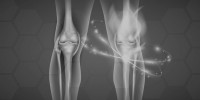
Chondrocyte Subpopulations in Osteoarthritis
Osteoarthritis (OA) is the most common joint disease. More than 22 percent of all people over 40 are affected by knee osteoarthritis, and 250 million people were affected in 2019. This joint inflammation is fueled by several risk factors, including age, weight, frequent joint use and stress, metabolism and genetics. There is progressive loss of articular cartilage, leading to pain and functional limitations. Degenerative changes in other surrounding tissues also occur. The quality of patients’ daily life is severely impaired.
Articular cartilage is composed of chondrocytes, the only cells in cartilage tissue, and the extracellular matrix (ECM), which is composed of collagen, proteoglycans, and water. If a person develops osteoarthritis, the delicate balance between synthesis and degradation of the ECM is disturbed. Studies have shown that aging of chondrocytes is responsible for the changes in ECM. This biological aging, which is a gradual deterioration of functional properties of specific cells or an organism, is called senescence. Features of chondrocyte senescence include accumulations of damaged proteins, lipids, and DNA in cells, changes in mitochondrial function, and impaired energy metabolism that promotes catabolic activity over anabolic activity in chondrocytes.
Thus, the focus of the disease is on chondrocytes, which could also serve as a starting point for the treatment of OA. But previous studies have focused on the general functions of chondrocyte populations in OA. In turn, most recent studies have focused on transplantation of expensive engineered cartilage tissue to treat cartilage degradation in OA. But they have rarely attempted to rescue or reverse the senescence of resident chondrocytes – and therefore to slow the rapid aging process.
Going into detail
That led researchers to study chondrocyte heterogeneity. Using single-cell RNA-seq (scRNA-seq) data from existing datasets, they analyzed single-cell sequencing data of chondrocytes from OA patients down to the smallest detail. As a result, they identified seven different subpopulations of chondrocytes. Those were nominated based on Gene Ontology and Kyoto Encyclopedia of Genes and Genomes analysis:
At a glance
Here are the key findings:
They found that stress-metabolizing chondrocytes were dominant in early stages of cartilage damage with increased metabolic levels inhibiting cartilage tissue degeneration, while the matrix-synthesis-related chondrocytes were mainly existed in the late stages of cartilage damage which reorganized collagen fibers with type III collagen disrupting the extracellular matrix and further cartilage damages.
 We identified seven different chondrocyte subpopulations, and noticed two different subpopulations, stress-metabolizing chondrocytes (cluster 1) and matrix-synthesis-related chondrocytes (cluster 4), preferably existed in early versus late OA stages with potential distinct functions.
We identified seven different chondrocyte subpopulations, and noticed two different subpopulations, stress-metabolizing chondrocytes (cluster 1) and matrix-synthesis-related chondrocytes (cluster 4), preferably existed in early versus late OA stages with potential distinct functions.
Furthermore, they identified genes NFKBIA and TUBB2B as potential markers for the stress-metabolizing chondrocytes and the matrix synthesis related chondrocytes, respectively.
Read more about the data, methods and findings here: https://www.sciencedirect.com/science/article/abs/pii/S0378111922008836